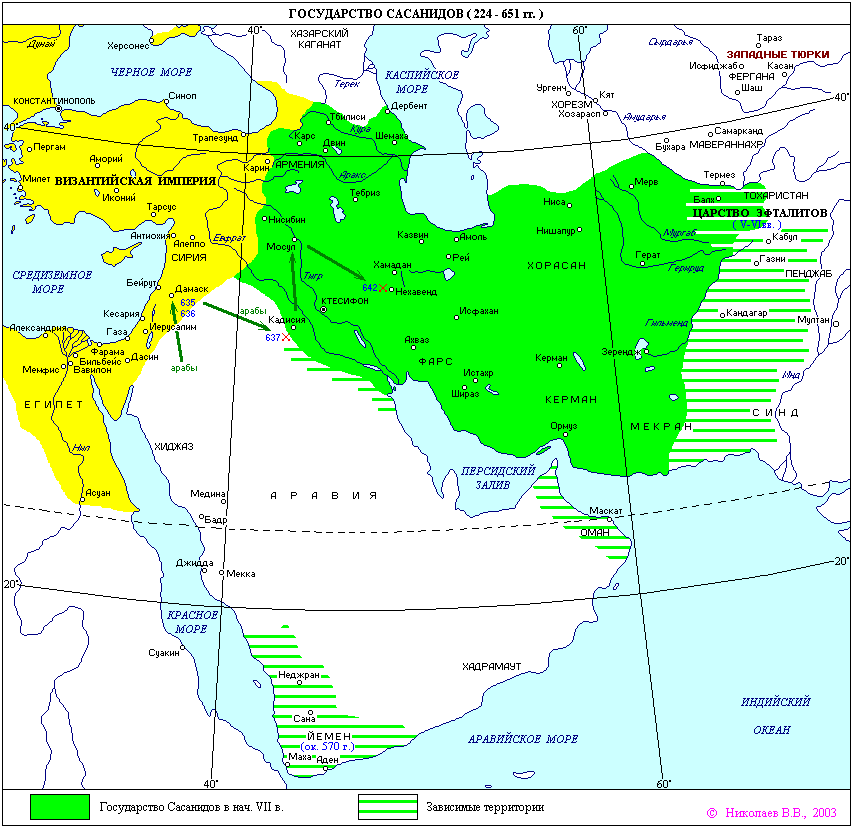The nearest neighbors to Muhammad’s Arabia (circa 600) were Abyssinia (modern Somalia and Ethiopia), “Rome,” and the Sasanian Empire of Persia. I put “Rome” in quotes because at that time, it included Egypt, some of North Africa, Palestine/Syria, Anatolia (modern Turkey), and all points west, excepting only, perhaps, Rome itself.
From 610 to 641, Heraclius was Emperor of Rome in Constantinople. His father had been the exarch (governor) of North Africa, and together they overthrew the former emperor. Power seesawed between Byzantine Rome and Persia as they fought a series of battles from 602 till 628.
Persian forces occupied Egypt from 619 to 621, when the Sasanian empire reached its greatest extent; at this time, Persia also occupied much of Southern and Eastern Arabia. Egypt had been majority Christian since some time in the 200s.

By 600, its bishops had a long history of conflict with the bishops who represented the imperial cities. They had already been declared heretics and experienced almost as much persecution as they had under Diocletian, the pagan Roman Emperor who became infamous for putting Christians to death. The Egyptians spoke Coptic (descendant of Pharaonic) at home and Greek in the government.
The Byzantine-Persian war finally ended when Emperor Heraclius personally led an army during winter into Persia, where they besieged the city of Nineveh. The Persians lost, and their emperor retreated to defend his capital city, Ctesiphon on the Tigris River. But there was no further need for war, as the Persian army mutinied and deposed him. All these details are generally summed up by the phrase, “by 628, both sides were exhausted.” Additionally, they were all still suffering from revisitations of the plague.
To the north of the imperial cities, ethnic groups from Central Asia were slowly moving into their old territories. The Persians made deals with the Avars and Huns to join their forces in besieging Constantinople. The Byzantines hired the Turks (also called Khazars) who had migrated into the Black Sea region. There were also Bulgars (a Turkic, not Slavic, people), who came from Kazakhstan. The old civilizations of the region were all under pressure from a constant influx of darker-skinned nomads in wagons, and this remained true for at least another four centuries.
The Goths, the earliest of the Germanic tribes to come down into Europe from somewhere in the Poland-Russia area, were settled into Italy, Spain, and the Crimean Peninsula. They were tall and blond; the Gothic languages vanished as they intermarried and joined the Latins and Celts who were already there. By 600, they were all Christians, but then the Lombards, another Germanic group, migrated south from Sweden and settled into northern Italy. There was little unity under the Pope in Rome; bishops were more territorial and ethnic, related to powerful families.
Farther west, the Merovingian kings ruled in France, but during the 600s, their personal power grew less as their Majordomos (“mayor of the palace,” or chief of staff) grew stronger.
The Angles, Saxons and Jutes had overrun Celtic Britain during the previous century. If King Arthur was a historical figure, his time was about one hundred years past by the time of Muhammad. Around 600, Latin missionaries were bringing Christianity to the Anglo-Saxons, as they had brought it to the Franks in the time of the first Merovingians. King Aethelberht of Kent had married a Christian Frankish princess, so his coastal kingdom was the first to accept the new religion, although his sons returned the kingdom to pagan worship. During the same time, King Raedwald of East Anglia, just north of them, was buried at Sutton Hoo with a magnificent pagan ship burial.
Scandinavia was the old heartland of the northern Germanic tribes, and it remained the land of Odin and Thor for many centuries yet. It had a lot of cultural exchange and travel with Denmark and England; eventually, it became the source of Viking attacks, but not yet in 600. Beowulf is set more or less in this time, too.
To the east, Christian adherents of Nestorius, a monk who had been declared a heretic, moved away from the Byzantine zone into Persia. The Persian empire was Zoroastrian. Sometimes it persecuted the Christians, other times not. There is still a Church of Assyria in Iraq, dating from this time. In general, Christian dissidents headed east, eventually going into India, China, and Mongolia.
China was ruled by the Tang Dynasty. It was a golden age of literature, and civil service exams were well-established by then. Central Asia had a variety of now-forgotten kingdoms, such as the Khitans, but the Tang Dynasty had just wrapped up a civil war and was expanding its territory.
India was split into many kingdoms, some allied with Persia, some having little to do with outside politics. It shared the Hindu religion with other parts of Southeast Asia, from Ceylon to Java. Buddhism was also dominant in eastern Asia, from the central kingdoms like the Khitan, to Java and Borneo.
North Africa was mainly Berber, with a strong remnant of Punic (Phoenician) farmers. St. Augustine, Bishop of Hippo (Algeria) until his death in 430, was probably part (or all) Berber, though his first language was Latin and he spoke a few words of Punic.
In West Africa, the Sahara caravan routes were controlled by the Empire of Wagadou, whose king was called the Ghana, so it’s often called the Ghana Empire. It wasn’t in modern Ghana, it was in the region of Mali and Mauritania. Its trade was in salt and gold; the same zone in later medieval years was a gold exporting powerhouse.
In North America, the mound-building cultures built some fairly large cities along the major rivers. The Hopewell culture created fine carved art, especially in their pipes, which archeologists have found in mounds throughout Illinois and Indiana.
Farther south, the year 600 finds the Mayan culture in its Classic period. The city of Tikal was at its peak of influence.

